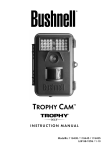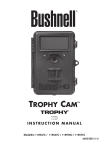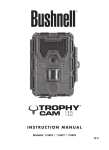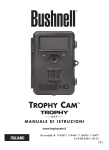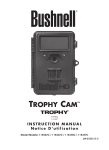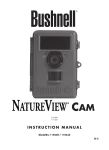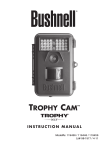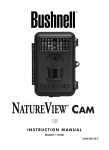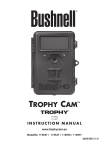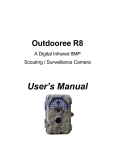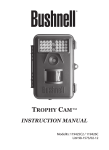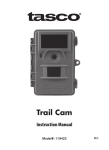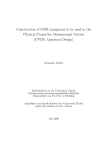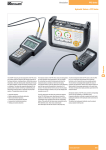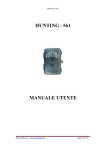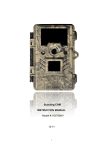Download Trophy Cam HD Wireless 119599C
Transcript
WIRELESS INSTRUCTION MANUAL Model#: 119599C 11-13 6 5 4 3 2 1 # Camera Name Serial # MY CAMERAS : REFERENCE LOG Location Page Index Important Note............................................................. 4 QUICK START GUIDE.................................................... 5 Managing Your Cameras Online............................... 8 Managing Your Cameras by Cell Phone App.......... 15 Introduction................................................................. 16 Parts and Controls....................................................... 17 Installing the Batteries and SD Card........................ 19 Using the Wireless Trophy Cam................................ 21 Operating Modes (Off/On/Setup)............................ 21 Using the Setup Menu................................................ 23 Using the Field Scan Feature..................................... 27 Setup Menu: Parameter/Settings Reference.......... 31 Camera Name and Coordinate Input....................... 39 Mounting and Positioning the Camera................... 40 Playing Back and Deleting Photos/Videos............. 42 Downloading Photos/Videos.................................... 42 FAQ................................................................................ 47 Troubleshooting.......................................................... 51 Technical Specifications.............................................. 57 Warranty....................................................................... 58 IMPORTANT NOTE Congratulations on your purchase of the Bushnell Wireless Trophy Cam! Bushnell is very proud of this camera and we are sure you will be pleased with it as well. Please refer to the notes below and the instructions in this manual to ensure that you are completely satisfied with this product. If your Bushnell Wireless Trophy Cam does not seem to be functioning properly or if you are having image quality issues, please check the FAQ/Troubleshooting section on pages 4756. Problems are often due to something simple that was overlooked, or require only changing one setting to solve. If your problem continues after trying the solutions in the Troubleshooting/FAQ section, please call Bushnell Customer Service at (800) 423-3537. In Canada, call (800) 361-5702. Bushnell recommends using a full set of 12 Energizer® Lithium AA batteries in the Wireless Trophy Cam to obtain maximum battery life Do not mix old and new batteries Do not mix battery types-use ALL lithium or ALL alkaline Bushnell recommends using SanDisk® SD and SDHC Cards (up to 32GB capacity, Ultra® or Extreme® series for HD video) in the Wireless Trophy Cam Note: the Bushnell Wireless Trophy Cam is not designed or intended for operation or sale outside of the United States. 4 Quick Start Guide 1. 2. 3. 1 Go to www.wirelesstrophycam.com and click “SETUP A NEW ACCOUNT”. Fill in your personal info and set your notification preferences. Click “CREATE”. Click the plus sign (+), name your camera and enter its serial number (printed inside the camera*). Click “ADD IT”. 2 3 *Note: we suggest taking a photo of your Trophy Cam’s serial number with your cell phone camera, to keep it handy for future reference. 5 Quick Start Guide 4. 5. 6. 7. 4 5 6 6 Open the camera’s latches and install 12 “AA” size batteries (lithium or alkaline). Insert SD card (up to 32 GB). Move camera’s power switch to the SETUP position, then press the MENU button. Select your preferred method of receiving images (Cell phone number or Email address). Press OK on the camera’s control panel. Enter your cell phone number or email address (Note: lower Quick Start Guide case letters are not necessary or provided in email settings). Press MENU. The camera will save your email address or cell number, then countdown and take a test photo. Note: the LCD display will power off while the camera is transmitting the image. If the camera is unable to connect to a valid cell phone # or email, the display will indicate “test photo send fail”. 9. The camera displays the signal strength for the last connection. Check your cell phone or email to verify the test image was received. 10. After you have verified the camera is transmitting images, move the switch to ON to initiate “live” triggering, and leave the area. 11. You can now log in to your account at wirelesstrophycam. com to view new images, change settings, and monitor the status of one or more wireless cameras. You can also control your camera(s) remotely via the Bushnell Wireless Trophy Cam app, a free download for iPhone® and Android™. 8. iPhone® is a registered trademark of Apple Inc. Android™is a trademark of Google Inc. 7 MANAGING YOUR CAMERA(S) ONLINE The camera will notify you when new images are captured and available for viewing. You can change the camera’s settings* by clicking the gear icon under the camera’s name. You can also remotely monitor the battery level, wireless signal strength, and remaining SD card space. * Note: it is not possible to set the Camera Mode to “Video” when Wireless Mode is switched on. Only still photos can be transmitted wirelessly, due to the large files generated by video and carrier bandwidth limitations. 8 MANAGING YOUR CAMERA(S) ONLINE Adding A Camera • • • Once your account is setup and you are logged in, you will see the My Cameras screen (a). To return to it at any time, click “My Cameras” at the top right of the webpage. The My Cameras screen allows you to quickly view images from any or all of your active cameras, display its location on a map or satellite photo, and monitor the current state of your battery level, remaining memory capacity, signal strength, service plan status, and even change the settings of any camera remotely. To add a new camera to the list, click “Add a camera” . Create a name for this camera, and enter its serial number (found inside the camera opposite the control panel) (b). Then click “Add it!” a b 9 MANAGING YOUR CAMERA(S) ONLINE Viewing Camera Images and Status • • • • • The thumbnail image to the left of a camera’s name represents the most recent photo that it captured (c). Click on the thumbnail to see an overview of all images captured to date from that camera (d). Click any single image to see a larger view, with options at the bottom of the window to download the thumbnail, get a high resolution image file, delete the image, or share it on Facebook™. Click the battery icon (e) to the right of the thumbnail image to display the current power level of the camera’s batteries. Click the signal strength icon (f) to display the condition of the camera’s transmitting signal. Click the memory capacity gauge (g) below the battery icon to display the percentage of the camera’s SD card that has been used. Click the gear icon (h) to open a new window (next page) that will allow you to change the camera’s settings remotely. c 10 d e f g h MANAGING YOUR CAMERA(S) ONLINE Changing Camera Settings After clicking the gear icon (h), a new window will open (i). This Camera Settings screen allows you to remotely change a wide range of parameters controlling your Wireless Trophy Cam’s operation from anywhere you have internet access. The settings that are available are listed below (click the blue “?” or see the full manual for a detailed explanation of each setting). • • • • • • • Camera Name Communication Frequency Night Vision Shutter Speed Image Resolution Camera Mode Captures Per Trigger Motion Sensitivity • • • • • • • LED Flash Intensity Delay Interval Image Overwrite Image Timestamp Field Scan Embed GPS Wireless Mode After you finish making all desired changed to the current camera settings, click “SAVE” to confirm and execute the changes. If you want to return to your original settings and start over, click “RESET” and “SAVE”. To remove this camera from your My Cameras group, click “REMOVE THIS DEVICE”. i 11 MANAGING YOUR CAMERA(S) ONLINE Checking Data Plan Status The white portion of the calender icon (j) shows the days remaining on your current data plan. Click the calender icon to open a window that allows you to purchase service plan extensions. j Displaying the Camera’s Location Hover your cursor over the map icon (k) to see the Lat/Long position of the camera. Click the map icon to view the camera’s location on a street map or satellite photo (click Map or Satellite to select). You can zoom in/ out, and drag on the map to move the view. k 12 MANAGING YOUR CAMERA(S) ONLINE Thumbnail Upload Enable/Disable Click the switch under “Upload Thumbnails” (l) to disable (or re-enable*) the automatic uploading of thumbnail images for a camera. This can be changed later, and will not interfere with your ability to communicate with the camera. *Note: allow up to 24 hrs for uploads to resume after re-enabling from “OFF” status. l OFF ON Displaying All Camera Locations Click “Display All Camera Locations” (near “MY CAMERAS”) to see an overview area map with markers representing each of your Wireless Trophy Cams. Note: the Coverage Viewer webpage (http://www.att.com/maps/edo/att-hplmn-broadband.html) is a useful tool to preview potential locations for your camera, but should not be considered a guarantee of wireless coverage, due to variable environmental conditions, terrain, etc. The successful reception of a test image is the best assurance that your camera will work in the location where you mount it. 13 MANAGING YOUR CAMERA(S) ONLINE Viewing All images Click “Display All Camera Locations” (above your first camera’s thumbnail image) to see a large “contact sheet” or grid view of all images captured to date from all cameras. Click any single image to see a larger view, with options at the bottom of the window to download the thumbnail, get a high resolution image file, delete the image, or share it on Facebook. 14 MANAGING YOUR CAMERA(S) BY CELL PHONE APP Using the Cell Phone App If you choose to have the initial test image sent to your cell phone number, when you receive it you will also be given the option of downloading Bushnell’s Wireless Trail Cam app. This easy to use app for iPhone® and Android™ provides most of the same features and functions described in the previous section, “Managing Your Camera(s) Online”. Here is the basic layout and operation of the app (Android version, iPhone is similar): Upper menu bar: Images/Cameras/Account Lower menu bar (when Images is selected in upper menu bar): Grid/List • Images shows thumbnails from All Cameras by default-tap All Cameras to select any individual camera. • Grid view shows larger thumbnail and date • List view shows smaller thumbnail, along with date and name of camera that captured image. • Tap any thumbnail to see a full screen view. Tap Cameras to display (in List view) latest thumbnail, battery and memory status for each camera. Tap any camera to get settings screen (camera name, communication frequency, etc.) Tap Account to change Notification Settings, including: • When new thumbnails are uploaded • When a camera fails to check in • When my batteries are low • When my SD card is nearly full • When my data plan requires attention Lower menu bar (when Cameras is selected in upper menu bar): List/ Map/Add • Map view shows location of each camera. • Add lets you add a new camera by entering its name and serial number. 15 INTRODUCTION About the Wireless Trophy Cam The Bushnell Wireless Trophy Cam is a digital scouting camera. It can be triggered by any movement of game in a location, detected by a highly sensitive Passive Infra-Red (PIR) motion sensor, and then take high quality pictures (up to 8MP still photos), or video clips. The Wireless Trophy Cam consumes very little power (less than 0.3 mA) in a stand-by (surveillance) state. This translates to a stand-by operating period ranging from weeks to months on a full set of 12 AA batteries, with the low end of the range based on alkaline batteries and frequent data transmission, and the high end contingent on the use of lithium batteries and a lower transmission frequency*. Once motion in the monitored area is detected, the digital camera unit will be triggered at once (typically within one second) and then automatically take photos or videos according to previously programmed settings. The Wireless Trophy Cam is equipped with built-in infrared LEDs (“black” IR LEDs that function as a flash, so that it delivers clear photos or videos (in black & white) even in the dark, and it can take color photos or videos under sufficient daylight. The Wireless Trophy Cam is designed for outdoor use and is resistant against water and snow. *An optional Solar Panel accessory (model# #119656C) can provide extended battery life. Please contact your Bushnell dealer for availability. Your Bushnell Wireless Trophy Cam represents the summit of our trail camera technology, including features such as: 16 • Auto PIR Sensitivity-the camera monitors ambient temperature conditions and automatically adjusts the sensor/trigger signal to be more sensitive to slight variations in temperature on hot days, less sensitive on cold days. • Hyper NightVision-The IR LED Flash array now has increased range, brighter output and better coverage for improved nighttime images. • Field Scan 2x with Live Trigger-Field Scan is a special feature which allows the camera to capture time lapse images or video. This has the advantage of giving you the ability to monitor the edge of a field that might be 50 or 150 yards away from the camera out of the PIR sensor’s range. Two independent “blocks” of time lapse recording can be setup, and the camera will still also record images when triggered by nearby animal activity as well. • GPS Geotag Capability-allows the user to input the longitude and latitude of the camera’s position, which will be embedded in each photo file. This enables Google Earth™, Picassa® and other geotag enabled software to automatically show a map pinpointing each camera’s location when a group of photos are reviewed on a computer. Especially useful for those who setup multiple Wireless Trophy Cams to monitor large or widely separated areas. • Multi Flash Mode (LED Control)- prevents overexposed flash photos in close range applications • NV Shutter-user can select shutter speed for images captured at night allowing control over brightness vs. ability to stop motion • Camera Operating Mode can be limited to Day only, Night only, or 24 HRs • Image Recycle option allows new photos/videos to begin replacing oldest files when SD card is at max. storage capacity, so recording will continue without interruption. And many more features such as HD Video with Audio, widescreen or fullscreen format still photos, imprintable camera name (user set) along with current data including temperature, moon phase and barometric pressure. Applications The Wireless Trophy Cam can be used as a trail camera for hunting or scouting game. It is also suitable for surveillance usage. PARTS AND CONTROLS The Wireless Trophy Cam provides the following connections for external devices: USB port, SD card slot, A/V Out, and external DC power in (pg 18, Fig. 1). A 3-way power switch is used to select the main operating modes: OFF, SETUP, and ON (pg 18, Fig. 2). A control key interface with six keys is primarily used in SETUP mode to select operational functions and parameters. As shown on the next page, these keys are: UP, DOWN, LEFT, RIGHT, OK and MENU. Four of the keys can also perform a second function (shortcut operations in SETUP mode) in addition to their main function: The DOWN key can be used to set the 17 Light Sensor FRONT VIEW Video Mic LED IR Flash Motion/ Low Battery Indicator Lens Lock Hole DC in Cover Plug Fig. 1: Connections PIR Sensor Latch INSIDE VIEW Tripod Socket Video Mic A/V Out DC In USB Port SD Card Slot Cable to Battery Compartment LCD Screen LEFT UP/Video MENU OK/Replay DOWN/Photo RIGHT/Shot Power/Mode (OFF/SETUP/ON) Switch 18 Fig. 2: Button and Switch Guide camera to Photo mode (still camera icon), and the UP key can set the camera to Video mode (movie camera icon). The RIGHT key also serves as the manual shutter (“SHOT”) button of the camera and the OK key switches the camera to the Playback (“REPLAY”) mode. These secondary functions are indicated by icons or text above the key as shown below. INSTALLING THE BATTERIES AND SD CARD Before you begin learning how to use your Wireless Trophy Cam, you will first need to install a set of batteries and insert an SD card. Although that may only take you a minute, there are some important notes about both batteries and SD cards you should be aware of, so please take the time to read the following directions and cautions: Loading Batteries After opening the two latches on the right side of the Wireless Trophy Cam, you will see that the Wireless Trophy Cam has twelve battery slots. Load the camera with a full set of 12 new batteries. Do not mix old and new batteries, and do not mix different types of batteries (use all lithium or all alkaline). Be sure to insert each battery with correct polarity (negative or “flat” end against the long spring of each battery slot). Bushnell recommends using a full set of new lithium AA (Energizer® brand) or alkaline AA batteries. NiMh Rechargeable batteries are not recommended, as the lower voltage they produce can cause operational issues. It is also possible to use a lead-acid external battery cell with 6V output or suitable AC adapter-see below for more details. Using an External Power Source (optional, user provided) Optionally, you can connect an external 6V DC power source to the “DC In” jack at the bottom of the Wireless Trophy Cam. It is recommended to use a power source with a current output of 2A. However, during bright daytime operation when no flash is required, the Wireless Trophy Cam can function with much less current ( >1000mA). Please use a compatible 19 power source cable (not provided) to connect the external DC power source with the power input jack of the Wireless Trophy Cam, making sure that the polarity is correct. Note: The power connector is a 4.0x1.7mm coaxial DC power plug with positive “tip” (inside pin) polarity (Radio Shack P/N 274-1532 or equivalent). If both an external power source is connected and batteries are installed, the Wireless Trophy Cam will be powered by the external power source. When the batteries become weak, the low-battery indicator LED will glow blue, indicating the batteries should be changed (pg 18, Front View). Note: an accessory solar panel (#119656C) is also available - please visit www.bushnell.com for more information. Inserting the SD Card The Wireless Trophy Cam has 32MB of internal memory, which can hold only about 20 photos (@ 5MP resolution). This is handy for testing and getting familiar with the camera, but you will no doubt want to leave the camera unattended for longer than a day, so using an SD card is recommended for all models. Insert the SD card (with the camera’s power switch in the OFF position) before beginning to operate the camera. Don’t insert or remove the SD card when the power switch is in the ON position. The Wireless Trophy Cam uses a standard SD (Secure Digital) memory card to save photos (in .jpg format) and/or videos (in .avi format). SD and SDHC (High Capacity) cards up to a maximum 32GB capacity are supported. High speed SD cards are recommended if you will use the 1280x720 video resolution setting (HD). Before inserting the SD card into the card slot after opening the camera’s front cover, please make sure that the write-protect switch on the side of the card is “off” (NOT in the “Lock” position). The following describes how to insert and remove the SD card: • 20 Insert the SD card into the card slot with its label side upwards (see below). A “click” sound indicates that the card is installed successfully. If the wrong side of the card is facing up, you will not be able to insert it without force-there is only one correct way to insert cards. If the SD card is not installed correctly, the device will not display an SD card icon on the LCD in SETUP mode (the SD card icon displayed after switching to SETUP mode will have a “lock” symbol inside it in it if the card is locked). Formatting the SD card by using the Wireless Trophy Cam’s “Format” parameter before using it for the first time is recommended, especially when a card has been used in other devices (see “Changing Menu Parameter Settings” for details). • To take out the SD card, just gently push in the card (do not try to pull it out without pushing in first). The card is released from the slot and ready to be removed when you hear the click. WARNING: Be sure the camera’s power is switched OFF before inserting or removing SD cards or batteries. USING THE Wireless Trophy Cam Once you’ve prepared your Wireless Trophy Cam by properly installing batteries and an SD card, you could simply take it outside, strap it to a tree, switch it on and leave-and you might get some great photos that are exactly what you wanted. However, we highly recommend that you first spend some additional time indoors with this manual and your camera until you know a bit more about what the 3-way switch and those control keys do. If nothing else, you’ll probably want to at least set the date and time so the camera will imprint them (or not-it’s your option) on your photos as they are taken, learn how to set the camera to shoot video clips instead of still photos if you like, and read some tips about mounting it on a tree. OPERATING MODES The Wireless Trophy Cam has three basic operational modes: • OFF mode: Power switch in the OFF position. • ON mode: Power switch in the ON position (LCD screen is off.) • SETUP mode: Power switch at SETUP position (LCD screen is on). 21 OFF MODE The OFF mode is the “safe” mode when any actions must be taken, e.g., replacing the SD card or batteries, or transporting the device. You will also use OFF mode if you connect the camera to a computer’s USB port later to download your photos/videos. And of course, when you are storing or not using the camera, you will switch it to OFF. Please note that even in the OFF mode the Wireless Trophy Cam still consumes power at a very low level. Therefore, it’s a good idea to take the batteries out of the battery compartment if the camera will not be used for a long time. ON MODE Anytime after the batteries and SD card have been inserted, you can switch on the camera. When the power switch is moved to the right position, the camera will enter into the ON (Live) mode. The motion indicator LED (pg. 18, “Front View”) will blink red for about 10 seconds. This interval allows time for you to close the Wireless Trophy Cam’s front cover, lock it, and leave the monitored area. Once in the ON mode, no manual controls are needed or possible (the control keys have no effect). The Wireless Trophy Cam will take photos or videos automatically (according to its current parameter settings) when it is triggered by the PIR sensor’s detection of activity in the area it covers. You can either move the power switch directly from OFF to ON mode, or stop at the SETUP position first to change one or more settings, then move the switch to ON after you have finished doing so. SETUP MODE 22 In the SETUP mode you can check and change the settings of the Wireless Trophy Cam with the help of its built-in LCD (or a monitor connected to the TV out jack). These settings, found in the SETUP Menu, let you change the photo or video resolution, interval between photos, switch the time imprint on, etc. Moving the power switch to the SETUP position will turn on the LCD display, and you will see an information screen that shows how many images have been taken, the battery level, camera or video mode, etc (Fig. 3, pg. 24). NOTE: Always move the power switch from OFF to SETUP mode. It is possible that the camera could lockup if it is switched from ON to SETUP mode. If this occurs, simply move the switch to OFF and then push it up to SETUP again. SETUP Mode Shortcut Keys/Functions As mentioned earlier in “Parts & Controls”, four of the keys below the LCD have secondary, “shortcut” functions when the camera is switched to SETUP mode (but the MENU key has not been pressed): • Press the UP key to quickly set the camera to shoot video clips. • Press the DOWN key to quickly set the camera to take still photos. • Press the RIGHT key to manually trigger the shutter. This is useful for testing the camera-make sure you are in SETUP mode, press the RIGHT key, and a few seconds later a photo or video (depending on how the camera was set) will be saved to the SD card (or internal memory if no card is inserted). The “number of images taken” counter on the bottom left of the LCD will increase by one. If the display indicates “SD PROTECTED” when you press the SHOT key, switch the camera OFF, remove the SD card and slide its protect switch off. • Press the OK key to replay (review or playback) photos/videos on the LCD, or a connected TV monitor (std. display models). See “Playing Back/Deleting the Photos/Videos” (pg. 42) for more details. Using the SETUP Menu The main purpose of the SETUP mode is to allow you to change the settings of the camera’s parameters (17 different ones are available) so your Wireless Trophy Cam operates exactly the way you want it to. You will do this by entering the SETUP Menu and pressing the keys below the LCD display, which will show you each parameter and its setting. Changing Parameter Settings in SETUP Mode A wide range of options or “parameters” are provided to allow you to set the Wireless Trophy Cam to your operational preferences. To change the setting of any parameter you must first switch to the SETUP mode. Once in SETUP mode, pressing the MENU button will allow you to select 23 Fig. 3: SETUP Information Screen Camera (Still Photo) Mode Image Size (Resolution) # of Photos Taken Camera Mode Remaining Photo Capacity Time Stamp ON Field Scan ON Battery Level SD Card Status Video Mode * Video Sound On Video Mode 24 Video Resolution Available Video Recording Time * Only still photos can be transmitted wirelessly, due to the large files generated by video and carrier bandwidth limitations. When the camera is set to video mode, the video files are stored on the SD card for later review (see PLAYING BACK/DELETING THE PHOTOS/VIDEOS, pg.42) any parameter and change its setting. The name of the parameter and its current setting will be shown on the LCD. Pressing the RIGHT or LEFT key scrolls to the next or previous parameter (RIGHT key to move on to the next parameter and LEFT key to go back to the previous parameter), and pressing the UP or DOWN key lets you select a different setting for the currently displayed parameter. Once you have selected your preferred new setting for a parameter, press the OK button to save the new setting (actually change it). When you are finished changing the settings of one or more parameters, press MENU again to exit the SETUP menu. MENU can also be pressed anytime you want to cancel changing a parameter’s setting after a new setting has been selected (but OK has not been pressed yet). After setting the parameters to your preferences, be sure to move the switch to ON to begin actually taking photos or videos. No images will be captured if the switch is left in the SETUP position (unless you press the RIGHT/Shot key after exiting the menu)-in fact, the camera will power off automatically after five minutes with no key pressed. Parameter Displays All the available settings for the currently displayed parameter are shown on one screen, with a checkmark next to the current setting (Fig. 4a, pg. 26). To change the setting, first use the UP/DOWN keys to highlight (select) the new setting you want (Fig. 4b), then press OK to “Execute” the actual change to the selected setting. The checkmark will appear next to your new setting to confirm this (Fig. 4c). EXAMPLES-Changing the Settings of Some Common Parameters Following this page, you will find tables listing all of the parameters found in the SETUP Menu, along with their possible settings (or range of settings), and a detailed description of what the parameter controls and what the settings do. If you read the previous section detailing how to select parameters and change their settings, you should be able to dive right in, find the parameter(s) you want, and setup the camera to suit your preferences. But maybe you’d rather walk through an example or two first: To change any parameter’s setting, always start with the power switch in the SETUP position. After the LCD comes on, press the MENU key. 25 Fig. 4: Selecting Parameter Settings Press MENU (4a) Press DOWN (4b) Press OK (4c) 26 The first parameter you will see when you first enter the SETUP Menu is “Mode”. To change it from its default setting of “Camera” (still photos) to “Video” (shoot video clips), press the DOWN key to highlight “Video”. Press the OK key to “Execute” (Set) the new setting you’ve selected for this parameter. Now press the RIGHT key to move to another parameter in the Menu. Pressing it three times will take you to “Capture Number”. Try using the UP and DOWN keys to scroll through the range of settings, then press OK to lock in your setting for the number of photos the camera takes each time it’s triggered. Pressing the RIGHT key until you reach the last menu item, you’ll see the “Default Set” parameter. Highlight or select “Execute” (using UP or DOWN) and press OK to restore all parameters (including the Mode and Video Length parameters you changed a minute ago) back to their original factory default settings. The default settings for each parameter are indicated in bold type in the SETUP Menu tables on the next several pages. Be sure to set the current date and time, using the “Set Clock” parameter, if you choose to change the “Time Stamp” parameter setting to “On” since that will tell the camera to imprint the date and time on each of the images it captures. USING THE FIELD SCAN FEATURE Field Scan is a useful special feature which allows you to monitor your food plots or field edges with time lapse images or video. When set to “On”, the Wireless Trophy Cam will take a photo (or record a video clip) automatically at your choice of intervals (for example, once every five minutes) during one or two blocks of time you set up for each day, without requiring a trigger from an active animal. This has the advantage of giving you the ability to monitor the edge of a field that might be 50 or 150 yards away from the camera out of the PIR sensor’s range. The result is an effective range much greater than it would normally be, with the camera dependant on triggers generated by nearby animals. This is a great tool for hunters to scout an entire field with only one camera. 27 If an animal does enter the area covered by the PIR sensor and generate a trigger event during a time in between the Field Scan intervals you set, the camera will capture an image or video just as it normally would, based on your other menu settings. Here’s how to setup and use Field Scan (be sure you’ve set the current time in “Set Clock” first, so your Field Scan recording will stop and start at the correct times of day): 1. Move the main switch to SETUP, then press MENU. 2. Keep pressing the RIGHT key, stepping through the Setup Menu until you reach Field Scan. 3. Press the UP key to select On, and press OK (Step 1, pg.30). You will see “A”, representing the first block of time you can define (a second block of time later in the day, “B” can also be setup if you wish). Press OK (Step 2). This takes you to the screen to set Start and Stop times, which determines the clock times when the first block of Field Scan recording will begin and end for each day. You can set these times to the exact hour and minute you want, for a recording “window” that lasts anywhere from just a minute to a full 24 hours. 4. Set the [Start] and [Stop] times, beginning with the Start hour, using the UP/DOWN keys to change the setting (Step 3). The hour setting is based on a 24-hour clock, with “00” hours = midnight, “12” hours = noon, “23” hrs = 11PM, etc. To move to the next setting, press the RIGHT key, change the minute for the Start time with UP/DOWN, then on to the hour and minute settings for the Stop time. 5. After you finish setting the Stop minutes, press OK to confirm your settings for the first block of Field Scan recording. If desired, you can create a second block of time by pressing the DOWN key to select “B” (Step 4), then press OK and follow the same process to set Start and Stop times for Field Scan block “B” (Step 5). As an example of how you might use these two available time blocks, you could setup Field Scan time block “A” for the dawn hours from 6 AM to 8 AM, and block “B” to capture images between 5:30 and 7 PM. No Field Scan recording would occur from 8 AM to 5:30 PM, or from 7 PM to 6 AM. 6. After setting Start/Stop times to define Field Scan block “A” and/or “B”, press OK, then press the UP or DOWN key to select “Interval” 28 and press OK (Step 6). The Field Scan “Interval” setting lets you control how often a photo or video clip is recorded during the block(s) of time you defined with the Start and Stop settings. Your options are 60 minutes, 30 minutes, 15 minutes, or 5 minutes (this is the default). Use the UP/DOWN keys to select your preference, then press OK to save it (Step 7). Note that for videos, “Interval” is independent of the Length of each video recording-it’s how often videos are recorded, not how long each one lasts. 7. Here’s an example of how the camera would operate, based on the following Field Scan settings: Field Scan: On Field Scan A: [Start]: 6:00 [Stop]: 8:00 Field Scan B: [Start]: 17:30 [Stop]: 19:00 Interval: 15M Note: avoid any "overlap" of Field Scan A & B recording blocks when setting their start and stop times, to assure correct operation. Start & Stop times must be in order, within the same day. If the "Camera Mode" menu parameter is set to "Day" or "Night" operation only, that will take priority over your Field Scan settings. Set the Camera Model to "24 HR" if you are setting both day and night start and/or stop times in Field Scan. These settings would cause the camera to capture a photo (or video, if the camera is set to that mode) once every 15 minutes, beginning at 6 AM, until the Field Scan “A” recording block stops at 8:00 AM. Later that day, the camera would again take a photo or video every 15 minutes between 5:30 PM and 7:00 PM (during Field Scan time block “B”). The next day, the camera would again record an image or video once every 15 minutes between 6:00 and 8:00 AM, and between 5:30 and 7:00 PM. No Field Scan recording would occur from 8AM to 5:30PM, or from 7PM to 6AM. Remember, Field Scan recording is independent of normal triggers due to animal activity–even if no animals enter the IR sensor coverage zone, an image or video will still be captured every 15 minutes during the block(s) of time. If an animal triggers the camera “in between” the 15 minute intervals, it will be recorded, same as it would if you had setup the camera with Field Scan turned Off. Note: Field Scan settings of frequent intervals and/or long periods between start and stop time can reduce battery life. 29 (Step 1)-set Field Scan Mode to “On” Steps 4 & 5 are optional (only required if you want to set up a second block of Field Scan recording with different stop and start times) Note: the Interval Setting sets the timing between each image for both Field Scan "A" and "B" recording blocks. (Step 2)-select Field Scan "A" (press OK) (Step 4) (opt)-select Field Scan "B" (press OK) (Step 6)-select Field Scan "Interval" Field Scan photos are saved to the SD card, but will not be transmitted wirelessly. images captured in field scan mode are stamped with a “T” icon (“Time Lapse”). Normally captured photos are stamped with an “M” icon (“Motion Trigger”) 30 “T” Icon indicates Field Scan mode photos (Step 3)-set Field Scan "A" Stop & Start (Step 5) (opt)-set Field Scan "B" Stop & Start (Step 7)-set Field Scan Interval Setup Menu: Parameter/Settings Reference Parameter Settings Description Mode Camera, Video* Selects whether still photos or video clips are captured when the camera is triggered. Image Size (only affects still photos in Camera mode) 3M Pixel, 5M Pixel, 8M Pixel, Selects resolution for still photos from 3 to 8 megapixels. Higher resolution produces better quality photos, but creates larger files that take up more of the SD card capacity (fills up faster). 5M is a good compromise between quality and file size. Image Format (only affects still photosformat for video is tied to Video Size) Full Screen, Wide Screen Selects 4:3 (Fullscreen, like old TV sets) or 16:9 (Widescreen, like new flat TVs) “aspect ratio” for still photos. If you like to view your photos on a TV set or computer monitor, you can set the format to match it. Capture Number (only affects still photos in Camera mode) 1 Photo, 2 Photo, 3 Photo Selects how many photos are taken in sequence per trigger in Camera mode. This setting affects photos taken in Field Scan mode as well (to snap two photos every 10 minutes, for example). Please also refer to the Interval parameter. (Bold=default) * Only still photos can be transmitted wirelessly, due to the large files generated by video and carrier bandwidth limitations. When the camera is set to video mode, the video files are stored on the SD card for later review (see PLAYING BACK/DELETING THE PHOTOS/VIDEOS, pg.42) 31 Parameter Settings Description IR LED Control (Multi-Flash feature) High, Medium, Low Controls how many LED lamps fire when images are taken in low light. “High”=all 32 LEDs fire, which is the default setting. Set to Medium or Low if you are getting overexposed flash photos or will place the camera at very close range to the subject you want to photograph. In general, select High if most of your intended subjects will be over 30 ft. from the camera, Medium for the 15 to 30 ft. range, and Low for subjects under 15 ft. away. Note: in video mode, 24 LEDs fire in both High & Medium (default) settings. Set to Low if videos are overexposed. Camera Name (Input) Allows the user to set a custom name for the camera. Useful for ID purposes when multiple cameras are setup, since each camera will imprint its name on all photos (but not videos) it captures. (Bold=default) See "Using the Setup Menu Input Screens" Video Size (only affects video clips in Video mode) 32 1280x720, 640x360 Selects video resolution (in pixels per frame). Higher resolution produces better quality videos, but creates larger files that take up more of the SD card capacity (fills up faster). The default 640x480 is VGA video in standard 4:3 format. The 1280x720 setting provides “widescreen” format HD video. Using high speed SD cards (SanDisk® Ultra® or Extreme® series or similar) is recommended if you will use the 1280x720 video setting. Parameter Settings Description Video Length (only affects video clips in Video mode) 10S (second) default, with 60S (60 seconds) to 5S (5 seconds) range Sets time length of each captured video clip. Settings begin with 10 second default when parameter is first selected. After stepping down to 5S, video length settings start over at 60S. Interval 10S (second) default, with a 60M (minute) to1S (second) range of settings available. Selects the length of time that the camera will “wait” until it responds to any additional triggers from the PIR after an animal is first detected and remains within the sensor’s range. During this user set “ignore triggers” interval, the camera will not capture photos/videos. This prevents the card from filling up with too many redundant images. Settings begin with 10 second default when parameter is first selected. Note: after setting down past “1S”, settings start over at “60M”. (Bold=default) (60M-1M are set in one minute increments, 59S-1S are set in one second increments) 33 Parameter Settings Description Sensor Level Low, Normal, High, Auto Selects the sensitivity of the PIR sensor. The “High” setting will make the camera more sensitive to infrared (heat) and more easily triggered by motion, and the “Low” setting makes it less sensitive to heat and motion. The High setting can be useful when the ambient temperature is warm (making it more difficult for the sensor to detect animals), and the Low setting may help in cold weather if the camera is being triggered too often by anything warmer than the surroundings. “Normal” is for average or moderate conditions. The default “Auto” setting will allow the camera to determine the best setting based on its current operating temperature. This is an ideal setting if the weather is expected to change significantly during the period the camera will be used. NV (Night Vision) Shutter High, Medium, Low Affects the shutter speed during Night Vision operation. High will freeze motion better, but photos may be darker. A Low shutter speed setting will produce brighter photos, but rapid motion may be blurred. Medium is a good compromise. Camera Mode Day, Night, 24hrs Allows user to limit operation to only day or night period if desired (default is 24 Hrs “round the clock”). An ambient light level sensor determines "Day" vs "Night" automatically. This setting takes priority over any Field Scan settings. (Bold=default) 34 Parameter Settings Description Format Execute (followed by an additional No/Yes step) Deletes (erases) all files stored on a card to prepare it for reuse. Always format a card that has been previously used in other devices. Caution! Make sure you have downloaded and backed up any files you want to preserve first! Press OK to execute, then select Yes and press OK again. Press MENU (or select NO then press OK) to exit without formatting. TV Out PAL, NTSC Selects video standard /format for the “A/V Out” output jack. The video standard is NTSC for the United States, Canada, Mexico, Asia and South America. PAL is used primarily in Europe. Time Stamp ON, OFF Select “On” if you want the date & time (that the image was captured) imprinted on every photo/video, select “Off” for no imprint. Note: the current temperature, barometric pressure, moon phase, and (user set) camera name will also be imprinted on your still photos. Set Clock (Set) Press OK and use the UP/DOWN keys (to change the setting) and LEFT/ RIGHT keys ( to move to the next field) to set the hour (24-hr format only, “00”=midnight, “12”=noon) and minute, and then (on the lower row), the year, month and date. Note: after the first wireless data transmission, the current time is automatically reset by the network. The time may not be correct on your 1st test image if you didn’t use “Set Clock” as described above to set it manually first. (Bold=default) 35 Parameter Settings Description ON, OFF (After On is selected): “A” Start/ Stop, “B” Start/ Stop, Interval Turns Field Scan (Time Lapse) recording mode on/off. When activated, Field Scan forces the camera to take photos or videos even when it is not triggered by a nearby live animal, useful for constant monitoring of an area that might be far away from the camera. The user can set the start and stop times for up to two independent “blocks” of Field Scan recording, as well as the interval time between each photo/video. To ensure correct operation, avoid setting overlapping start/stop times for Field Scan A and B. Please read the “Field Scan 2x…” section of this manual (pgs 27-30) for details on using this feature. NOTE: If the "Camera Mode" parameter is set to "Day" or "Night" operation only, that will take priority over your Field Scan settings. Set Camera Mode to "24HR" if you are setting day and night Field Scan start and/or stop times. ON, OFF Allows the user to input latitude and longitude coordinates for the camera’s location. This data will be embedded in the files saved on the camera’s SD card (if “On” is selected). This makes it possible to see each camera’s location as a “pushpin” on Google Earth™ maps when reviewing a folder full of photos from multiple cameras, or use other “geotag” capable software (Picassa®, etc). (Bold=default) Field Scan Note: images captured in field scan mode will be saved to the SD card, but will not be transmitted wirelessly. Coordinate Input 36 See "Using the Setup Menu Input Screens" Parameter Settings Description Set Video Sound (only affects video clips) ON, OFF Select “ON” to record audio along with the video when the camera is set to video mode (saved file sizes will be slightly larger). Image Recycle ON, OFF Select “ON” (default) if you want the oldest photos/videos to be replaced by new images once the SD card is full. Select “OFF” if you want operation to stop when the card is full. Press OK. Wireless Mode ON, OFF Select “OFF” to operate the unit as a standard trail camera, with no wireless transmission of images (captures photos & videos will be stored on the SD card). NOTE: once OFF is selected, it is not possible to re-activate Wireless operation remotely via internet or phone app, only by selecting ON on the camera itself. Transmit Frequency Quick, Never Selects how often captured photos are sent to your cell phone or email. The default “Quick” setting will transmit each image transmitted soon after it is captured (battery life will be reduced). “Never” is similar to turning Wireless Mode off (no images will be transmitted)-but this can be changed once per day via remote communication back to “Quick” , enabling transmission to resume. (Bold=default) (NOTE: setting Image Recycle to “ON” is not recommended when using 16GB or higher capacity SD cards) 37 Parameter Settings Description Execute, Cancel Select “Execute” and press OK to restore all parameters to the original factory default settings. If the camera is behaving oddly and you think you may have changed the setting for something accidently (but aren’t sure which one), this will reset all parameters to their most commonly used or “generic” settings. (Bold=default) Default 38 CAMERA NAME AND COORDINATE INPUT SCREENS Camera Name Input After selecting the Camera Name parameter (the only setting is “Input”), press OK. If necessary, delete the previous or default name by pressing the RIGHT key until the backspace symbol ( ) (located between letters “A” & “B”, also between “j” & “k”) is highlighted, then keep pressing OK. Select (highlight) each alphanumeric character you want, using the LEFT/RIGHT keys, and pressing OK after each one to set it. When finished naming the camera, press MENU to save the name to memory. Coordinate Input After selecting the Coordinate Input parameter, press UP or DOWN to select the On setting and press OK. The latitude and longitude for any location where you plan to place the camera can be obtained at many websites, for example: http://itouchmap.com/latlong.html. You can enter a nearby street address, just zip code, or use the various types of maps to locate the approximate position. The format you will need to use to enter the coordinates in the Wireless Trophy Cam menu screen is shown below: Degrees N=North, Latitude S=South (3 digits) Minutes Seconds Latitude (La) N000,00'00" Longitude (Lo) W000,00'00" Degrees W=West, Longitude Minutes Seconds E=East (3 digits) Note: You may see "negative" latitude or longitude coordinates online. These designate South latitudes and West longitudes. US/Canada locations will have North (+) latitude coordinates and West (-) longitude coordinates. 39 MOUNTING AND POSITIONING THE WIRELESS TROPHY CAM Mounting After you’ve set up the camera’s parameters to your personal preferences at home or in your truck, you’re ready to take it outside and slide the power switch to “ON”. When setting up the Wireless Trophy Cam for scouting game or other outdoor applications, you must be sure to mount it in place correctly and securely. We recommend mounting the Wireless Trophy Cam on a sturdy tree with a diameter of about 6 in. (15cm). To get the optimal picture quality, the tree should be about 16-17 ft. (5 meters) away from the place to be monitored, with the camera placed at a height of 5-6.5 ft. (1.5~2 m). Also, keep in mind that you will get the best results at night when the subject is within the ideal flash range, no farther than 45’ (14m) and no closer than 10’ (3m) from the camera. There are two ways to mount the Wireless Trophy Cam: using the provided adjustable web belt, or the tripod socket. Using the adjustable web belt: Fig. 5 illustrates using the web belt on the Wireless Trophy Cam. Push one end of the belt through the two brackets on the back of the Wireless Trophy Cam. Thread one plastic buckle part onto each end of the belt. Fasten the belt securely around the tree trunk by clicking the buckle ends together after tightening the belt so there is no slack left. Using the tripod socket: The camera is equipped with a socket at Fig. 5: Attaching the Belt 40 the bottom end to enable mounting on a tripod or other mounting accessories with a standard1/4-20 thread. Three optional accessories, a Bear Safe” protective box (119655C), Deluxe Tree Bracket (119652C) and Solar Power panel (119656C) are also availableplease see your Bushnell dealer or www.bushnell.com for more details. Sensing Angle and Distance Test To test whether the Wireless Trophy Cam can effectively monitor the area you choose, this test is recommended to check the sensing angle and monitoring distance of the Wireless Trophy Cam. To perform the test: • Switch the Wireless Trophy Cam to the SETUP mode. • Push the MENU button twice to enter the “Live View” mode. • The display will now let you preview the area covered by the camera in its current position. • Make movements in front of the camera at several positions within the area where you expect the game or subjects to be. Try different distances and angles from the camera. • If the motion indicator LED light blinks, it indicates that position can be sensed. If it does not blink, that position is outside of the sensing area. The results of your testing will help you find the best placement when mounting and aiming the Wireless Trophy Cam. The height away from the ground for placing the device should vary with the animal size appropriately. In general, 3 to 6 feet is preferred. You can avoid potential false triggers due to temperature and motion disturbances in front of the camera by not aiming it at a heat source or nearby tree branches or brush (especially on windy days). Switching ON the Camera Once you switch to the ON mode, the motion indicator LED (red) will blink for about 10 seconds. This gives you time to close and lock the front cover of the Wireless Trophy Cam and then walk away. During this time, the motion indicator LED will blink red continuously. After it stops 41 blinking, the PIR is active, and any motion that is detected by it will trigger the capture of photos or videos as programmed in the SETUP Menu. Be sure you have read the descriptions of the Capture Number, Video Length, Interval and Sensor Level parameters. Please note, the PIR is strongly sensitive to ambient temperature. The greater the temperature difference between the environment and your subject, the farther the possible sensing distance. The average sensing distance is about 45 ft. Before leaving the camera unattended, please check for the following: • Are the batteries or DC power supply inserted/connected with correct polarity and is the power level is sufficient? • Does the SD card have sufficient available space and is its writeprotection (lock) switch off? • Is the Power switch in the ON position? (do not leave it in SETUP). PLAYING BACK/DELETING THE PHOTOS/ VIDEOS After you have setup, mounted and activated your Wireless Trophy Cam, you will of course be eager to return later and review the images it has captured for you. There are several different ways to do this: 1) Reviewing Images Remotely via Website/Apps Please refer to pages 10, 14 and 15 in the Quick Start Guide section at the front of this manual for details on how to review your camera’s images online or with our smartphone application. 2) Reviewing Images Directly From the SD Card This is the most popular method of viewing images. Since unmounting the camera and taking it to your computer isn’t very convenient, you may find it easier to just take the card out. By removing the SD card (swapping it for a new empty card if you like) and taking it to your home or campsite to view the images by using an SD card “reader” (user supplied) connected to your computer (some computers and TVs have a built in SD card slot), you can leave the camera in place ready to capture more images. Once connected, the card reader works the same way as described belowplease read that section if you have any problem finding your files. 42 3) Reviewing Images on the Wireless Trophy Cam Color LCD • Put the power switch in SETUP mode (switch to OFF first). • Push the MENU key twice to go to “live view” mode, then press OK. • If you are in still photo mode, you’ll see the still photo review screen. If you are in video mode, you’ll see the video review screen. • Use the UP/DOWN keys to scroll through your photos or videos. A zoom feature is available for still photos: first press the LEFT key, then use the UP/DOWN keys to zoom in or out. After zooming in, you can then press OK, and use the UP/DOWN/ LEFT/RIGHT keys to move around and examine small details in different areas of the photo. Press OK at anytime to exit and return to the full view. • Press the RIGHT (Shot) key to play a video. If “Video Sound” was set to “On” in the Setup Menu, you should hear audio from the speaker during playback. • Push MENU to delete an image. Image delete mode works as described below. To exit image review mode, press the OK key. 4) Reviewing Images on an External Video Monitor A TV monitor can also be used to play back pictures (or videos) from the device. Connect a TV monitor or a viewing device (such as a digital picture frame) that has a standard composite video input (RCA jack) to the Wireless Trophy Cam “A/V Out” 1/8” mini jack using a compatible (user supplied, 1/8” to RCA) cable. Then: Cable from • Put the power switch in SETUP mode (switch to “A/V Out” OFF first). • Press the OK key. The most recently captured image will be shown on the video monitor. For video clips, press the SHOT (RIGHT) key to start playing, press again to stop. • Press the UP key for the previous photo or video and the DOWN key for the next one. When viewing images, the total number of all images in the SD card and the index of the displaying image are shown in the center of LCD and at the bottom of the video monitor respectively. • Press the OK key to return to live preview state (SETUP mode) when playback is finished. 43 5) Reviewing Images by Connecting the Camera to a Computer You can always unmount the entire camera from the tree and connect its USB port to a computer-it will be recognized as a “removable disk”, without the need to install any drivers or software. When using a PC (or Mac*) to view photos (or video clips*), first connect the device to the computer with the supplied USB cable. Then use commercial software with an image browser feature, or an image browser included with the PC’s operating system to view images saved on the SD card in the folder \ DCIM\100EK113 (a new folder will be created every 1000 images). Each new image or video will be numbered incrementally in order of the time it was captured. For example, you will see file names such as “EK0001.JPG” or “EK0001.AVI”, etc. Through the file format suffix you can distinguish whether the file is a still photo (with suffix .JPG) or a video (with suffix .AVI). *video files may require additional software for viewing on a Mac. The Wireless Trophy Cam supports 3 kinds of file system formats, FAT12, FAT16, and FAT32. The default value is FAT16 to save photos and videos. Here are some related notes: • You don’t need to be concerned about the file system format of the Wireless Trophy Cam unless your equipment has problems reading the SD card. If this happens, please format the SD card with the Wireless Trophy Cam or in your computer first and then insert the card into your Wireless Trophy Cam and try again. • The default file system format of the Wireless Trophy Cam is FAT16, which most computers can read. If you format an SD card for the Wireless Trophy Cam in your computer, you should choose the file system format FAT16. Normally FAT16 is recommended unless you have another image viewer that uses FAT12 or FAT32 format. Deleting Photos or Videos 44 If you see a photo or video during playback on the LCD or video monitor that you want to delete, it can be done easily without leaving SETUP mode: • Press the MENU key. You will see the first “Delete” screen, which lets you selects the option to delete only the currently displayed photo/ video, or all photos/videos (see below). • Highlight the “Delete Current” or “Delete All” option, then press OK. • Next, select “Yes” and press OK to erase only the last displayed photo or video (if you selected “Delete Current”), or every photo and video file on the card (if you selected “Delete All”)-or select “No” and press OK to cancel the operation without deleting any files. NOTE: after deleting a picture or a video file, the deleted files can’t be restored! It is also possible to delete all files from the card by using the Format parameter (see pg. 35). DOWNLOADING THE PHOTOS/VIDEOS To download your photos/videos to a PC or Mac, first make sure the Wireless Trophy Cam power switch is in the OFF position. Connect the supplied cable to the camera’s USB port, then directly to a main USB port on your computer-do not use front panel/keyboard USB ports or unpowered “hubs”. The Wireless Trophy Cam will be recognized as a standard “USB Mass Storage” device (this may take several seconds the first time you connect it). If you would rather leave your camera in the woods and just pull its SD card out, an SD card reader works the same way as described in this section once the card is inserted and the reader is connected to your computer. With Windows XP or later, you can then simply use the options in the pop-up window to copy, view, or print your photos (right). 45 On all Windows OS, the Wireless Trophy Cam will also be listed as a “Removable Disk” if you open the “My Computer” window (on Macs, an icon will appear on your desktop). The Wireless Trophy Cam’s photo files are named “EK0001.JPG” etc, and are located in the “DCIM\100EK113” folder on this “Removable Disk”. Once the number of images in the folder exceed the limit of 999 files (after file name EK0999.JPG), a new folder is automatically created (DCIM\101EK113). Video file names will end with “.AVI”. You may copy the photos/videos to your hard drive as you would any file-just copy/paste or drag the file names or icons to your drive or desktop. After the photos are copied to your hard drive, you can disconnect the Wireless Trophy Cam. (On Mac computers, drag the “disk” that appeared on your desktop when the camera was connected into your Trash to “eject” it before disconnecting.) The .JPG format photo files from the Wireless Trophy Cam may be viewed and edited with any photo software you choose to use. The .AVI video files may be viewed with the Windows Media Player on PCs with Windows 7. If your computer is running an older version of Windows, or you are on a Mac, and you don’t already have a compatible video player, you can download a free version of the DivX player from http://www.divx.com/. 46 WIRELESS TROPHY CAMERA FAQs Q: How can I view my Wireless Trophy Camera images remotely? A: You can view the photos using your cell phone, email, or online management system. Q: Will the Wireless Trophy Camera send field scan thumbnails to my Trophy cam app or online management site? A: No the Wireless Trophy Camera will only wirelessly transmit motion triggered photos. Q: Will the Wireless Trophy Camera send video to my Trophy cam app or online management site? A: No the Wireless Trophy Camera will only wirelessly transmit motion triggered photos. Q: Do I need to pay for the Wireless Trophy Camera smart phone app? A: No, the App is a free download for iPhone/Android. Q: Can I add multiple Wireless Trophy Cameras to one user log in? A: Yes, under “My Cameras” you can add new cameras by clicking “Add a camera”. Q: Can I remove Wireless Trophy Cameras from “My Cameras” group? A: Yes, under “My Cameras” simply click “Remove This Device”. Q: Can I change Wireless Trophy Camera settings from my online management site? A: Yes, you can change setting by clicking the gear icon underneath your camera name. Q: Can I check Wireless Trophy Camera battery life from my online management site? A: Yes, you can check battery life by clicking the battery icon underneath your camera name. Q: Can I check Wireless Trophy Camera memory capacity from my online management site? A: Yes, you can check memory capacity by clicking the memory capacity gauge underneath your camera name. Q: Can I check Wireless Trophy Camera wireless signal strength from my online management site? A: Yes, you can check wireless signal strength by clicking the signal strength bars underneath your camera name. Q: Can I have a high resolution file from one of my thumbnails? A: Yes, by clicking on the thumbnail you have the option to delete image, share on Facebook, or purchase a high resolution image file. 47 Q: What format does the Wireless Trophy Camera save images in? A: The Wireless Trophy Camera saves photos in .jpg format and videos in .avi format. Q: What Wireless Trophy Camera settings will I be able to remotely change? A: You can change the following settings remotely; • Camera Name • Communication Frequency • Night Vision Shutter Speed • Image Resolution • Camera Mode • Captures Per Trigger • Motion Sensitivity • LED Flash Intensity • Delay Interval • Image Overwrite • Image Timestamp • Field Scan • Embed GPS • Wireless Mode Remember to click “Save” after making setting changes. Q: Can I check how many days I have left on my Wireless Trophy Camera data plan? A: Yes, simply check the calendar icon under “My Cameras”, this will display how many days you have remaining. Q: How do I purchase another Wireless Trophy Camera data plan from my online management site? A: Click on the calendar icon to purchase a Basic, Deluxe, or Elite data plan. Q: How do I cancel my Wireless Trophy Camera data plan? A: Click on the calendar icon and select “Cancel Data Plan”. Q: Where is the serial number located on my Wireless Trophy Camera? A: The serial number is located on the inside in the top right hand corner above the menu screen. 48 Q: Why do I get images from a camera in another time zone and they appear to be 1 hour in the future? A: If you have multiple cameras and one is in a time zone later than the time zone you are located, it would appear to you that camera is sending images in the future. Q: How do I get a full resolution image from my camera? A: Buy a high resolution image or use a high resolution download credit that you’ve previously purchased or retrieve the full resolution image from the SD card. Q: Can the camera have a manually set date and time? A: No, the date and time are pulled from the cellular wireless network and are not manually set. Q: Can I use this wireless camera on a network other than AT&T? A: No, all Wireless Trophy Cams operate on the AT&T network. Q: Do I need the smartphone app to make the camera work? A: No, the smartphone apps are a free additional resource. If you choose to not download those, you can still manage the camera remotely and view images from the user website Q: Why does the camera show my location in Kansas? A: The default location is centered in the US. You can set your location remotely from the camera settings on the website or on the camera before deployment in the field. Q: I moved my camera and the images are not in the correct order, why is that? A: If you move your camera to a different time zone your pictures will be stamped with the date and time of the new time zone. Q: Can I use my camera without a data package installed? A: Yes, the camera can operate without a data plan. You would not be able to view images from the camera or change settings remotely however. Q: How do I set my camera to field scan for a period that spans past midnight? A: To accomplish that, you need to field-scans: 12am-7am and 7:01am-11:59pm and for example. The FieldScan is a range of hours in a single day. Q: Why do I see skipped images on website or APP? A: Field Scan Images will not be transmitted to the website or APP. Q: Why do I see skipped images on website or APP overnight? A: The camera does a nightly check in every night, while doing so it may utilize field scan to trigger the camera in which case it will not transmit those images but may store them to the SD card. 49 Q: How do I completely delete a camera from my account? A: You must first go into settings and select “remove from account”. Next you must go in and delete all images. Once all images are deleted the camera will no longer appear on your account grayed out. Q: How do I turn off alerts to my phone, email or app? A: You can accomplish this via the account settings page on the website or on the app. Q: What if I lose wireless signal on the camera—will it continue to take images? A: If you lose connectivity to the network, the camera will continue to take images like a normal trail cam and save them to the SD card. FOR THE LATEST, UPDATED FAQs, PLEASE VISIT www.bushnell.com/global/customer-service 50 TROUBLESHOOTING Camera takes continuous images of no subject A camera has what is known as a “false trigger” if the PIR sensor thinks that there is motion and heat in front of the camera lens when there is no subject in the image. These “False Triggers” are the result of placing the camera in an environment where there is motion associated with tree branches creating motion in front of the camera or an area where there is high heat in the foreground and any motion from wind could set off the camera. Setting a camera up over water is also a potential cause for this issue. To remedy this situation: 1. Try moving the camera to an area that does not have any of these issues or try changing the sensor level on the menu settings. 2. If the camera continues to take images when there is no subject in them, try placing the camera in an inside environment and aiming at a location where there is no motion. 3. If the camera continues to show issues, then there is probably an electronic component issue. If this is the case, please contact our customer service to send the camera back for repair. Battery life is shorter than expected 1. Battery life will vary with operating temperature and the number of images taken over time. Typically, the Wireless Trophy Cam will be able to capture several hundred images before the batteries die. 2. Check to make sure you have used new alkaline or lithium batteries. Bushnell recommends using a full set of Energizer® Lithium AA batteries in your Wireless Trophy Cam model to obtain maximum battery life. 3. Make sure that the power switch was turned to the “On” position and that the camera was not left in “Setup” mode while in the field. 4. Make sure that you are using a good quality name brand SD card in your camera. Bushnell recommends SanDisk® brand SD Cards up to 32GB (Ultra® or Extreme® series for HD video). Our experience indicates that poor quality SD cards can sometimes reduce your Wireless Trophy Cam battery life. 51 TROUBLESHOOTING Camera stops taking images or won’t take images 1. Please make sure that the SD card is not full. If the card is full, the camera will stop taking images. 2. Check the batteries to make sure that they are new alkaline or lithium AA batteries. See note above about short battery life. 3. Make sure that the camera power switch is in the “On” position and not in the “Off” or “Setup” modes. 4. Make sure that you are using a good quality SD card in your camera. Bushnell recommends SanDisk® SD Cards up to 32GB (Ultra® or Extreme® series for HD video) . 5. If the SD card has its write protect switch in the lock position, the camera will not take images. 6. If you have used an SD card in another device before inserting it in your Wireless Trophy Cam, you might want to try formatting the card using the “Format” parameter in Setup mode (make sure you have backed up any important files first, as formatting will erase all previous files). In some cases, other devices may change the formatting of the SD card so that it will not work properly with the Wireless Trophy Cam. Camera won’t power up 1. Make sure that you have installed at least 4 batteries (the required minimum #) in the battery compartment, starting at the top, filling battery spaces 1-4 with no “gaps”. Bushnell recommends using a full set of 12 Energizer® Lithium AA batteries in your Wireless Trophy Cam. 2. Make sure that the batteries are installed correctly, observing proper polarity. Always place the negative (flat) end of each battery in contact with the spring side of its slot inside the camera. 3. After moving the switch from “Off” to “Setup” or “On”, make sure that the switch is correctly in position to ensure the proper mode (avoid positions “between” two modes). 4. Do not move the switch directly from “On” to “Setup”-always move the switch all the way down to “Off” first, then back up to “Setup”. 52 TROUBLESHOOTING Still Photo and/or Video Quality Problems 1. Night photos or videos appear too dark a. Check the battery indicator icon to see if battery power is full. The flash will stop operating near the end of the battery life. b. You will get the best results when the subject is within the ideal flash range, no farther than 45’ (14m) from the camera. Subjects may appear too dark at greater distances. c. Please note that when the Capture Number parameter is set higher than “1 Photo”, or with very short Interval settings, some images may appear darker than others due to the quick response and rapid retriggering of the camera, allowing less time for the flash to fully recharge before firing again. d. Make sure “LED Control” in the setup menu is set to “High” to ensure maximum output. You can also try setting “NV Shutter” in the menu to “Low” (slower shutter speed=brighter images, with tradeoff of increased blur if subject moves rapidly). 2. Daytime photos or videos appear too dark a. Make sure that the camera is not aimed at the sun or other light sources during the day, as this may cause the auto exposure to produce darker results. 3. Night photos or videos appear too bright a. If the subject is close to the camera (less than10ft/3m), change the LED Control parameter in the Setup Menu to “Medium” or “Low”. 4. Daytime photos or videos appear too bright a. Make sure that the camera is not aimed at the sun or other light sources during the day. 5. Photos with streaked subject a. In some cases with low lighting conditions and fast moving subjects, the 5MP or 8MP resolution settings may not perform as well as the 3MP setting. b. If you have multiple images where fast moving subjects produce streaks on the photo, try the 3MP setting instead. c. Set “NV Shutter” to “High” to minimize motion blur. 53 TROUBLESHOOTING 6. Red, green or blue color cast a. Under certain lighting conditions, the sensor can become confused resulting in poor color images. b. If this is seen on a consistent basis, then the sensor may need servicing. Please contact Bushnell customer service. 7. Short video clips—not recording to the length set a. Check to make sure that the SD card is not full. b. Make sure that the camera has good batteries in it. Near the end of the battery life, the camera may choose to record shorter video clips to conserve power. Date/Time Stamp not appearing on images 1. Make sure that the “Time Stamp” parameter is set to “On”. Photos Do Not Capture Subject of Interest 1. Check the “Sensor Level” (PIR sensitivity) parameter setting. For warm temperature conditions, set the Sensor Level to “High” and for cold weather use, set the sensor for “Low”. For variable weather, use “Auto”. 2. Try to set your camera up in an area where there is not a heat source in the camera’s line of sight. 3. In some cases, setting the camera near water will make the camera take images with no subject in them. Try aiming the camera over ground. 4. Try to avoid setting the camera up on small trees that are prone to being moved by strong winds. 5. Remove any limbs which are right in front of the camera lens. PIR Sensor LED Flashes/Doesn’t Flash 1. When the camera is in the “Setup” mode, a special LED on the front of the camera will flash when it senses motion. This is for setup purposes only and will help the user aim the camera. 2. During use, the LED will not flash when the camera takes an image. This is to help keep the camera hidden from game. 54 TROUBLESHOOTING LCD Screen Issues 1. LCD screen powers on but no text is present. a. After moving the switch from “Off” to “Setup” or “On”, make sure that the switch is correctly in position to ensure the proper mode (avoid positions “between” two modes). b. Do not move the switch directly from “On” to “Setup”-always move the switch all the way down to “Off” first, then back up to “Setup”. 2. Screen comes on but then powers off a. Make sure that you have installed the SD card correctly. Camera won’t retain settings Make sure that you have been saving the changes to any parameter settings that you made while in Setup mode, by pressing “OK” after changing the setting. If you don’t save your new setting after changing it, the camera will continue to use the original default setting for that parameter. Moisture or Ants Inside Camera 1. To ensure humidity or rain is kept out of the camera, secure the DC In plug firmly in place. 2. Ants can be attracted by low level electronic vibrations, and enter through any gaps between the exterior and interior of the camera. Make sure the DC In plug is securely attached. Field Scan (Time Lapse) not working properly 1. Make sure that the stop and start times of Field Scan “A” and “B” do not overlap (for example, do not set the start time of “B” to 8AM if the stop time of “A” is 10AM). 55 TROUBLESHOOTING Difficulty removing the batteries Before removing the batteries from the Wireless Trophy Cam you can simply remove the battery compartment insert bar by grasping it in the middle and lifting out. This will give you easier access to the batteries. After removing them, you can replace the battery compartment insert bar by inserting one side into the battery compartment wall and flexing the insert until you can place the second side of the bar into the opposite wall of the battery compartment. Make sure that the bar is seated securely. The bar should be inserted with the text/numbers printed on the insert facing correctly up so that you can read them. Make sure that the insert bar is inserted correctly inside the battery compartment before replacing batteries. Battery Compartment Insert Bar Camera responds slowly, does not always capture image when triggered Avoid setting the “Image Recycle” parameter to ON when an SD card with capacity of 16 GB or higher is inserted. The Image Recycle feature requires some time to scan the card and determine the oldest file(s) to delete and replace with the newest files (images). The larger the card, the more time this will take, and the camera may perform significantly slower with high capacity cards if the overwrite feature is activated. There should be no issue using Image Recycle with smaller capacity cards (<16 GB), and the feature is provided to offer a useful option when limited capacity cards are used, or when it it not practical to check the camera and replace (or download and format) the card on a frequent basis. 56 Do not mix old and new batteries. Do not mix battery types-use ALL lithium or ALL alkaline. Rechargeable batteries are not recommended. TECHNICAL SPECIFICATIONS Image Sensor 5 Megapixel Color CMOS Maximum Pixel Size 3264x2448 (8MP) Lens F = 3.1; FOV=45°; Auto IR-Cut-Remove (at night) IR-Flash Range Selectable (Low/Med/High), up to 45’(14m) on High Display Screen Color Display: 32x42mm (2.4”) Memory Card SD or SDHC Card, Maximum capacity 32GB Internal RAM 32MB Picture Size 8MP = 3264x2448; 5MP = 2560x1920; 3MP = 2048x1536 Video Size 1280x720 (widescreen) or 640x360 (fullscreen) pixels per frame at 20-30 fps (Day) / 15-20 fps (Night) PIR sensitivity Hyper PIR with 4 sensitivity settings: Low/Normal/High/Auto Operation User selectable: 24 Hour, Day only, or Night only (based on ambient light level) Response Time 0.7 second Triggering Interval 1 sec. - 60 min. programmable Shooting Numbers 1— 3 programmable Video Length 5-60sec. programmable Power Supply 12x AA batteries recommended, 4xAA as emergency power Stand-by Current < 0.3mA (<7mAh/day) Power Consumption 250mA (+1300mA when all LEDs fire) Night Vision Shutter Speed User selectable (High/Med/Low)-affects night (NV) photos/ videos only Interface A/V out (NTSC/PAL); USB; SD card holder; 6V DC external Security Strap; ¼-20 attachment Operating Temperature -20 - 60°C (Storage temperature: -30 - 70°C) Operating Humidity 5% - 90% 57 90 DAY LIMITED WARRANTY Your Bushnell® Wireless Trophy Cam is warranted to be free of defects in materials and workmanship for 90 days after the date of purchase. In the event of a defect under this warranty, we will, at our option, repair or replace the product, provided that you return the product postage prepaid. This warranty does not cover damages caused by misuse, improper handling, installation, or maintenance provided by someone other than a Bushnell Authorized Service Department. Any return made under this warranty must be accompanied by the items listed below: 1. A check/money order in the amount of $10.00 to cover the cost of postage and handling 2. Name and address for product return 3. An explanation of the defect 4. Proof of Date Purchased 5. Product should be well packed in a sturdy outside shipping carton, to prevent damage in transit, with return postage prepaid to the address listed below: Bushnell Outdoor Products Attn.: Repairs 9200 Cody Overland Park, Kansas 66214 ©2013 Bushnell Outdoor Products Note: the Bushnell Wireless Trophy Cam is not designed or intended for operation or sale outside of the United States. Note: the Coverage Viewer webpage (http://www.att.com/maps/edo/att-hplmn-broadband.html) is a useful tool to preview potential locations for your camera, but should not be considered a guarantee of wireless coverage, due to variable environmental conditions, terrain, etc. The successful reception of a test image is the best assurance that your camera will work in the location where you mount it. 58 Specifications and designs are subject to change without any notice or obligation on the part of the manufacturer. FCC Compliance Statement: This equipment has been tested and found to comply with the limits for a Class B digital device, pursuant to part 15 of the FCC Rules. These limits are designed to provide reasonable protection against harmful interference in a residential installation. Operation is subject to the following two conditions: (1) This device may not cause harmful interference, and (2) this device must accept any interference received, including interference that may cause undesired operation. This equipment generates, uses and can radiate radio frequency energy and, if not installed and used in accordance with the instructions, may cause harmful interference to radio communications. However, there is no guarantee that interference will not occur in a particular installation. If this equipment does cause harmful interference to radio or television reception, which can be determined by turning the equipment off and on, the user is encouraged to try to correct the interference by one or more of the following measures: • Reorient or relocate the receiving antenna. • Increase the separation between the equipment and receiver. • Connect the equipment into an outlet on a circuit different from that to which the receiver is connected. • Consult the dealer or an experienced radio/TV technician for help. The device does not contain any user-serviceable parts. Repairs should only be made by an Authorized Bushnell repair center. Unauthorized repairs or modifications could result in permanent damage to the equipment, and will void your warranty and your authority to operate this device under Part 15 regulations. The shielded interface cable which is provided must be used with the equipment in order to comply with the limits for a digital device pursuant to Subpart B of Part 15 of FCC Rules. FOR END USER LICENSE AGREEMENT AND TERMS/CONDITIONS OF USE, PLEASE VISIT WWW.WIRELESSTROPHYCAM.COM This product features technology licensed from Zipit Wireless, Inc. (“Zipit”), that is copyrighted work of, and may be patented by, Zipit Wireless, Inc. Copyright 2003-2013 Zipit Wireless, Inc. All rights reserved. Access to the Zipit services may be bound by EULA and Privacy policies located at www.bushnell.com or www.zipitwireless.com/legal. iPhone® is a registered trademark of Apple Inc. Android™ and Google Earth are trademarks of Google Inc. Picassa® is a registered trademark of Google Inc. 59 For further questions or additional information please contact: Bushnell Outdoor Products 9200 Cody, Overland Park, Kansas 66214 (800) 423-3537 • www.bushnell.com ©2013 Bushnell Outdoor Products




























































